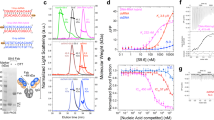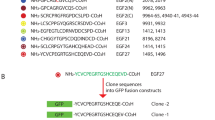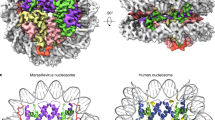Abstract
ANTIGENIC determinants of nucleic acids may comprise individual bases or base sequences, as in denatured DNA, or specific conformational features, as in helical forms1. Experimentally induced antibodies have shown selective reactivity toward double-stranded RNA2–6, RNA–DNA hybrids4, or distinct features of poly(G) · poly(C)7 or poly (dG) · poly(dC)4. Some of these antibodies can be used to identify double-helical RNA in virus-infected cells8,9 and to quantitate it in RNA extracted from such cells10, or to distinguish between double-stranded RNA and RNA–DNA hybrids in mixtures of enzyme reaction products11. Triple-helical poly(A) · 2poly(U) can also be distinguished from double-helical forms2,9. Triple-helical regions can form where continuous purine sequences occur12, and they might be involved as intermediates or as recognition sites in transcription13,14. Thus antibodies that recognise triple-helical nucleic acids are important in the definition of conformation-dependent antigenic determinants, as a model for protein recognition of specific nucleic acid sites, and they may identify such sites in naturally occurring nucleic acids. We describe here such antibodies that can differentiate three-stranded structures built on poly(A) from others built on poly(dA).
This is a preview of subscription content, access via your institution
Access options
Subscribe to this journal
Receive 51 print issues and online access
$199.00 per year
only $3.90 per issue
Buy this article
- Purchase on Springer Link
- Instant access to full article PDF
Prices may be subject to local taxes which are calculated during checkout
Similar content being viewed by others
References
Stollar, B. D., in The Antigens, 1, 1–85 (edit. by Sela, M.) (Academic Press, New York, 1973).
Nahon, E., Michelson, A. M., and Lacour, F., Biochim. biophys. Acta, 149, 127–139 (1967).
Schwartz, E. F., and Stollar, B. D., Biochem. biophys. Res. Commun., 35, 115–120 (1969).
Stollar, B. D., Science, 169, 609–611 (1970).
Plescia, O. J., Strampp, A., and Kwiatkowski, Z., Fedn. Proc., 28, 695 (1969).
Talal, N., Steinberg, A. D., and Daley, G. G., J. clin. Invest., 50, 1248–1252 (1971).
Nahon-Merlin, E., Michelson, A. M., Verger, C., and Lacour, F., J. Immun., 107, 222–226 (1971).
Silverstein, S. C., and Schur, P. H., Virology, 41, 564–566 (1970).
Stollar, B. D., and Stollar, V., Virology, 42, 276–280 (1970).
Stollar, V., and Stollar, B. D., Proc. natn. Acad. Sci. U.S.A., 65, 993–1000 (1970).
Colby, C., Stollar, B. D., and Simon, M. I., Nature new biol., 229, 172–174 (1971).
Morgan, A. R., and Wells, R. D., J. molec. Biol., 37, 63–80 (1968).
Zubay, G., Proc. natn. Acad. Sci. U.S.A., 48, 456–461 (1962).
Miller, J. H., and Sobell, H. M., Proc. natn. Acad. Sci. U.S.A., 55, 1201–1205 (1966).
Plescia, O. J., Braun, W., and Palczuk, N. C., Proc. natn. Acad. Sci. U.S.A., 52, 279–285 (1964).
Poonian, M. S., Schlabach, A. J., and Weissbach, A., Biochemistry, 10, 424–427 (1971).
Felsenfeld, G., Davies, D. R., and Rich, A., J. Am. chem. Soc., 79, 2023–2024 (1957).
Stevens, C. L., and Felsenfeld, G., Biopolymers, 2, 293–314 (1964).
Riley, M., Maling, B., and Chamberlin, M. J., J. molec. Biol., 20, 359–385 (1966).
Rich, A., Proc. natn. Acad. Sci. U.S.A., 46, 1044–1053 (1960).
Arnott, S., and Bond, P. J., Nature new biol., 244, 99–101 (1973).
Kabat, E. A., J. Immun., 97, 1–11 (1966).
Wasserman, E., and Levine, L., J. Immun., 87, 290–295 (1961).
Wahba, A. J., and Friedkin, M., J. biol. Chem., 237, 3794–3801 (1962).
Buchanan, J. G., Nature, 168, 1091 (1951).
Author information
Authors and Affiliations
Rights and permissions
About this article
Cite this article
STOLLAR, B., RASO, V. Antibodies recognise specific structures of triple-helical polynucleotides built on poly(A) or poly(dA). Nature 250, 231–234 (1974). https://doi.org/10.1038/250231a0
Received:
Issue Date:
DOI: https://doi.org/10.1038/250231a0
This article is cited by
-
MEG3 long noncoding RNA regulates the TGF-β pathway genes through formation of RNA–DNA triplex structures
Nature Communications (2015)
-
Chromatin signatures and retrotransposon profiling in mouse embryos reveal regulation of LINE-1 by RNA
Nature Structural & Molecular Biology (2013)
-
Potential sites of triple-helical nucleic acid formation in chromosomes of Rhynchosciara (Diptera: Sciaridae) and Drosophila melanogaster
Chromosome Research (2009)
-
Nucleic acid reactive antibodies— specificities and applications
Journal of Biosciences (1985)
Comments
By submitting a comment you agree to abide by our Terms and Community Guidelines. If you find something abusive or that does not comply with our terms or guidelines please flag it as inappropriate.



